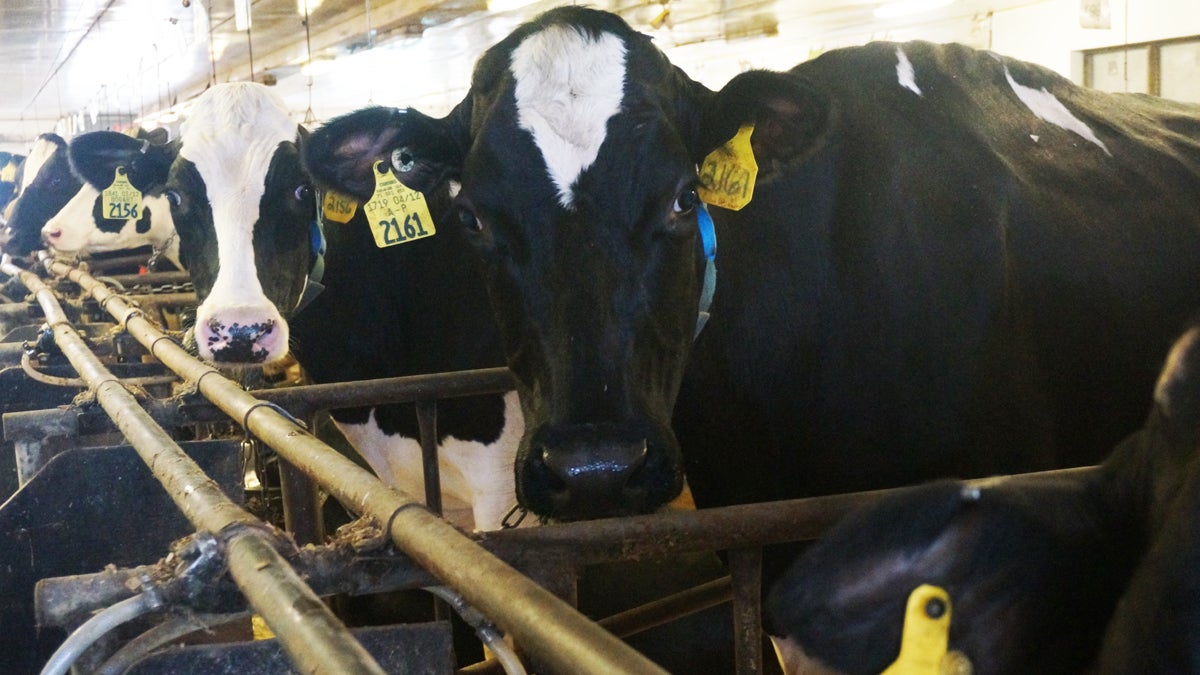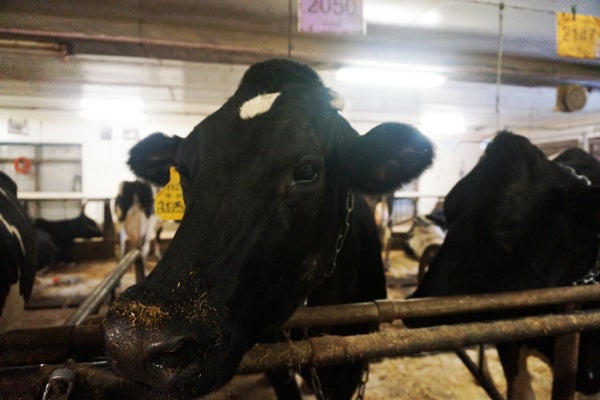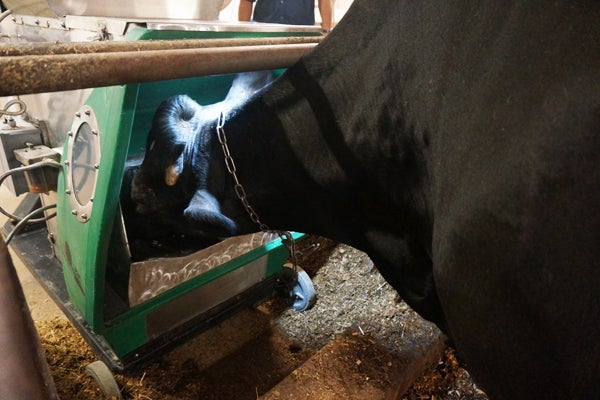Saving the planet, one cow burp at a time
Listen
In this stock photo, black and white Holstein dairy cows are in their stalls in Penn State's research barn.
A methane blocker might be the secret to more environmentally friendly burgers and milkshakes.
The belching inside Penn State University’s research dairy barn is constant.
“They burp gas all the time,” says animal science professor Alex Hristov, of his herd of 60 black and white Holstein cows.
For a place with so much burping, though, it’s eerily quiet, with just an occasional deep moo from a resident or two. The cows are happily corralled in two long rows of stalls, each animal with a yellow tag on her ear. More than a few are munching on feed.
“They milk about 100 pounds of milk a day,” says Hristov, proudly, with a Bulgarian accent. “They eat a lot, so they’re good cows.”
All that eating, of course, is responsible for the round-the-clock burping. And even though cow belches, or eructations, are silent, that doesn’t mean they go unnoticed here. Because the breaths contain methane, the scientists are keenly interested in finding a way to prevent them.
Measuring burps
Like carbon dioxide, methane is a greenhouse gas that contributes to climate change. It doesn’t last as long as in the atmosphere, but over a century, it traps heat 25 times better than its better-known cousin.
Methane’s potency is one reason why environmentalists are so concerned about natural gas leaks. The Porter Ranch disaster in southern California spewed more than 200 million pounds of methane before it was finally plugged in mid-February. But each year, cows in the U.S. burp out 65 times more gas than was released in the now infamous leak. Globally, about a quarter of methane pollution comes from livestock.
Hristov and his team study ways to reduce those emissions, so they have gotten very good at quantifying the amount their cows exhale. Prompted by some extra snacks, cow number 2050 ducks her head into a hooded machine that records the amount of methane, hydrogen, and carbon dioxide in her burps. During experiments, the scientists take eight measurements from each cow over several days. In a few months, this gives a snapshot of just how much methane the animals churn out — and whether particular interventions work to slash that pollution.

Thanks to specialized bacteria that help digest food, cows are major producers of methane. Almost all of the gas is exhaled in burps rather than farts. (Jessica McDonald/for WHYY)
A natural fermentation product
The reason cows are such big producers of methane is part of what makes them so special: they can eat things humans – or even other farm animals, including pigs – can’t, like grass and hay.
“It’s all because of a symbiotic relationship with the bacteria in their rumen,” explains Hristov.
The rumen is the first section of the cow’s famous four-compartment stomach. It’s where the food is first broken down into a slush. Unlike human stomachs, which rely on acid to deconstruct food, cow rumens depend on an arsenal of microbes. Trillions of bacteria are doing the hard work of digestion, fermenting feed so that it can be turned into flesh or milk.
Fermentation produces a lot of hydrogen gas, which stops digestion if it builds up too much. To keep the process going, specialized bacteria, called methanogens, rid the rumen of excess hydrogen by combining it with carbon dioxide. The result is methane, which exits the cow in a silent burp. Contrary to popular belief, very little methane actually comes out the other end.
“Cows don’t really release anything from their backside,” says Hristov.
One way to reduce the environmental impact of cow digestion is to chemically block the creation of methane in the gut. Hristov’s group has been testing an inhibitor made by DSM Nutritional Products that is added to cow feed to do just that. It’s called 3-nitrooxypropanol, or 3NOP, and prevents an enzyme in bacteria from powering the last step of methane formation.
So far, the compound appears to work. In Penn State’s study, which was partially funded by DSM, methane emissions fell by 30 percent, compared to controls. The decrease persisted for the entire 12-week period the cows were on the drug, and milk production didn’t suffer. Hristov, who previously evaluated a variety of natural herbs and oils for similar effects, sees 3NOP as a breakthrough.
“I’ve been working with methane for probably 15 years now and this is the most exciting result that we have so far,” he says.

Cow number 2050 demonstrates the GreenFeed machine, which sucks up her belches to measure the amount of methane. The Penn State team uses the portable instrument on the herd during experiments. (Jessica McDonald/for WHYY)
Not yet a cash cow
Lots of tests are now needed to make sure the compound is safe for cows – and, of course, the humans who drink the milk. Even if 3NOP survives further scrutiny, its environmental potential might never be realized if farmers don’t buy it. And right now, carbon trading systems don’t exist to put monetary value on lowering methane emissions.
“At this point, there are no incentives for a dairy producer in the U.S. to use a methane inhibitor,” says Hristov. “So just reducing methane is not going to sell this.”
Methane inhibitors, curiously enough, have historically been of interest to the beef industry, precisely because they might save ranchers money.
Andy Cole, a retired USDA scientist in Texas, studied the drugs back in the mid-’70s for his Master’s degree.
“That was before the term greenhouse gas or global warming had ever been used,” recalls Cole.
At the time, the idea was just to find a more efficient, cheaper way to raise cattle. Methane was a target because up to 10 percent of a cow’s food is wasted on making the gas.
“That’s energy that possibly could have ended up in the muscle or in the milk,” says Cole.
By cutting down on methane, the animals could put those calories to better use, bulking up faster or pumping out more milk without having to be fed more food.
Conceptually, methane inhibitors were potential cash cows. But Cole never found a drug that worked well. Many of the substances researchers evaluated, such as chloroform or the ozone-depleting chemical bromochloromethane, were toxic or harmful to the environment.
Forty years later, Hristov’s 3NOP looks promising. FDA approval is still needed before it can come to market, but the compound appears safe. And while the drug hasn’t yet demonstrated an economic benefit, there are signs it might in the future. In preliminary tests, for example, cows on the drug made milk with more protein than controls – good news to farmers who sell milk to make cheese. Cows on the inhibitor also gained 80 percent more weight, an indication that in the next milking cycle, there might be a boost in output.
“The few unanswered questions have to be answered,” cautions Hristov. “But all the data we have are extremely positive. There are no concerns at this point. We just have to continue working.”

A view inside Penn State University’s dairy research barn, where scientists are testing a feed additive for its ability to decrease cows’ methane emissions. Methane is a potent greenhouse gas. (Jessica McDonald/for WHYY)
WHYY is your source for fact-based, in-depth journalism and information. As a nonprofit organization, we rely on financial support from readers like you. Please give today.



